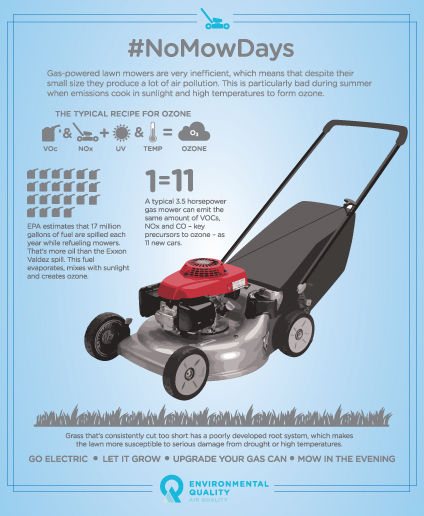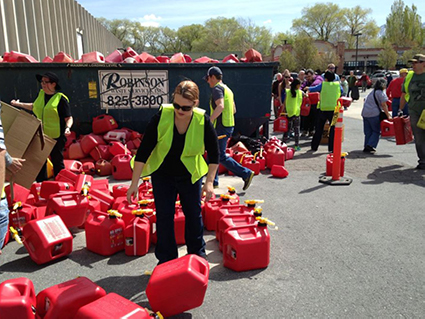By Christine Osborne

It’s been a tough summer for air quality. Wildfires and ozone have kept many of us indoors as Utah continues to log “Unhealthy” air days and some of the highest summer ozone readings we’ve seen for a while. So we make fewer trips, take public transit, and telework to reduce our emissions to help improve our air quality.
But most of us don’t think about air pollution when we’re mowing our yards or shopping for new lawn and garden tools. Did you know that lawnmowers, leaf blowers, trimmers, and other gasoline-powered lawn equipment produce a lot of air pollution? According to the Environmental Protection Agency (EPA), gas-powered lawnmowers account for five percent of the air pollution in the United States and contribute even more pollution in urban areas. Five percent!
That number starts to make sense when you look at the statistics:
- Each weekend, about 54 million Americans mow their lawns, amounting to 800 million gallons of gas per year.
- The emissions from one four-stroke lawnmower operating for one hour are equivalent to an average vehicle traveling 500 miles.
- Using a gas-powered mower for one hour produces the same amount of emissions as 11 new cars also running for an hour.
- At least 17 million gallons of gasoline are spilled annually just filling these lawnmowers.
The good news? Small changes in your choices in lawn equipment and mowing practices can make a big difference.
Go Electric
Trading your gas-powered mower for an electric mower is an easy way to reduce your emissions. Electric mowers have come a long way in recent years. Most models use long-lasting lithium-ion batteries, so you don’t have to fiddle with a cord — or worse, worry about running over it! Unlike gas mowers, you don’t have to the change spark plugs, fuel filters, or oil. Electric mowers are light, easy to use, and quiet. And they don’t emit the volatile organic compounds (VOCs) and nitrogen oxides (NOx) that contribute to ozone. And if you want a good workout, an old-fashioned reel mower gets the job done with zero emissions.
Let It Grow
The taller your grass, the healthier your lawn. There is a direct correlation between the height of the grass and the depth of the roots. If you mow your lawn down to two inches, you will have two inches of roots. If you mow at four inches, you will have four inches of roots. That added root mass will make your lawn more drought- and disease-resistant, provide natural weed control, and reduce the amount of water you need to keep your lawn healthy.
Upgrade Your Gas Can

You may not realize it, but the type of gas can you use can make a big difference in your VOC emissions. If you use an older gas can, vapors can permeate the walls and fumes can escape when you dispense fuel. That 17 million gallons of gas spilled annually? Older cans are a part of the problem. And even when you aren’t using your mower, VOCs can escape from secondary vent holes and inadequately capped spouts on these older cans.
New gas cans, on the other hand, provide an automatic shut-off feature to prevent overfilling and an automatic closing feature to prevent VOCs from leaking when the can isn’t in use. Thicker walls reduce vapor permeation, and the elimination of secondary venting holes prevents spills and fumes. Newer EPA-approved gas cans are relatively inexpensive and can make a big dent in VOC emissions.
Mow in the Evening
Ground-level ozone is formed when the VOCs and NOx combine with sunlight. If you fill your gas tank or mow your the lawn in the morning, you put ozone-forming emissions into the air during the “prime time” for ozone to form. If you mow your lawn after 7 p.m., you give ozone-forming chemicals a chance to dissipate overnight. Once the sun starts to set, reduced daylight makes ozone formation more difficult. Evening winds can also disperse ozone and reduce pollution levels for the following morning.
Take More #NoMowDays
If the air quality is bad, skip mowing altogether. If you’ve ever wanted an excuse to NOT mow your lawn (and haven’t we all?), here it is! Check ozone levels on our website or the Utah Air App on your iOs or Android mobile device. You can also check the three-day forecast to see if you should mow today — or wait — based on projected weather conditions and air pollution levels.
Small changes can make a big difference! While we can’t stop the wildfire smoke or stagnant air conditions, we can change our behaviors to reduce emissions and help our air quality. To learn more about green lawn-and-garden products, visit the Utah Clean Air Partnership (UCAIR) website and select Choose Green for more information.
I am a content strategist/communication specialist at the Utah Department of Environmental Quality. I have a Masters in Strategic Communication (MSC) degree from Westminster College and earned my Accreditation in Public Relations (APR) from the Public Relations Society of America (PRSA). I currently teach Integrated Marketing Communication to graduate students in the MSC program at Westminster. In a previous life, I was a bassoonist with the Utah Symphony for 26 years. I love to hike, bike, camp, read, garden, geek out on all things science, and spend time with two college-age sons. I volunteer with a number of local refugee organizations and am currently a teen mentor with the 4-H New American Goat Club and Teen Leadership Club.

